An arborist is a specialist in the care of individual trees. Arborists are knowledgeable about the needs of trees and are trained and equipped to provide proper care. Hiring an arborist is a decision that should not be taken lightly. Proper tree care is an investment that can lead to substantial returns. Well-cared-for trees are attractive and can add considerable value to your property. Poorly maintained trees can be a significant liability. Pruning or removing trees, especially large trees, can be dangerous work. Tree work should be done only by those trained and equipped to work safely in trees.
OUR SERVICES
Why Hire an Arborist?

What Is a Certified Arborist?
Pruning Services

An arborist can determine the type of pruning necessary to maintain or improve the health, appearance, and safety of trees.
These techniques include:
- eliminating branches that rub each other
- removing limbs that interfere with wires, building facades, gutters, roofs, chimneys, or windows, or that obstruct streets or sidewalks
- removing dead or weak limbs that pose a hazard or may lead to decay
- removing diseased or insect-infested limbs
- creating better structure to lessen wind resistance and reduce the potential for storm damage
- training young trees
- removing limbs damaged by adverse weather conditions
- removing branches, or thinning, to increase light penetration
- improving the shape or silhouette of the tree
Planting Services
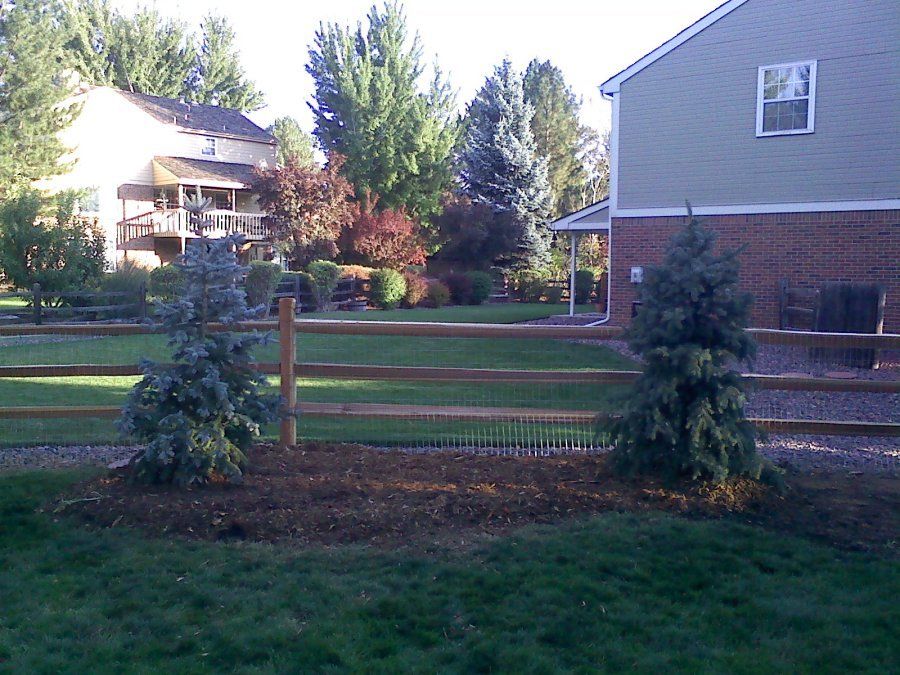
Some arborists plant trees, and most can recommend types of trees that are apprpriate for a specific location. The wrong tree in the wrong location could lead to future problems as a result of limited growing space, insects, disease, or poor growth.
New Tree Planting
Think of the trees you just purchased as a lifetime investment. How well your tree, and investment, grows depends on the type of tree and location you select for planting, the care you provide when the tree is planted, and follow-up care the tree recieves after planting.
Planting the Tree
The ideal time to plant trees and shrubs is during the dormant season and in the fall after leaf drop or early spring before budbreak. Weather conditions are cool and allow plants to establish roots in the new location before spring rains and summer heat stimulate new top growth. However, trees properly cared for in the nursery or garden center, and given the appropriate care during transport to prevent damage, can be planted throughout the growing season. In tropical and subtropical climates where trees grow year round, any time is a good time to plant a tree, provided that sufficient water is available. In either situation, proper handling during planting is essential to ensure a healthy future for new trees and shrubs. Before you begin planting your tree, be sure you have had all underground utilities located prior to digging.
If the tree you are planting is balled or bare root, it is important to understand that its root system has been reduced by 90 to 95 percent of its original size during transplanting. As a result of the trauma caused by the digging process, trees commonly exhibit what is known as transplant shock. Containerized trees may also experience transplant shock, particularly if they have circling roots that must be cut. Transplant shock is indicated by slow growth and reduced vigor following transplanting. Proper site preparation before and during planting coupled with good follow-up care reduces the amount of time the plant experiences transplant shock and allows the tree to quickly establish in its new location. Carefully follow nine simple steps, and you can significantly reduce the stress placed on the plant at the time of planting.
- Dig a shallow, broad planting hole. Make the hole wide, as much as three times the diameter of the root ball but only as deep as the root ball. It is important to make the hole wide because the roots on the newly establishing tree must push through surrounding soil in order to establish. On most planting sites in new developments, the existing soils have been compacted and are unsuitable for healthy root growth. Breaking up the soil in a large area around the tree provides the newly emerging roots room to expand into loose soil to hasten establishment.
- Identify the trunk flare. The trunk flare is where the roots spread at the base of the tree. This point should be partially visible after the tree has been planted (see diagram). If the trunk flare is not partially visible, you may have to remove some soil from the top of the root ball. Find it so you can determine how deep the hole needs to be for proper planting.
- Remove tree container for containerized trees. Carefully cutting down the sides of the container may make this easier. Inspect the root ball for circling roots and cut or remove them. Expose the trunk flare, if necessary.
- Place the tree at the proper height. Before placing the tree in the hole, check to see that the hole has been dug to the proper depth and no more. The majority of the roots on the newly planted tree will develop in the top 12 inches of soil. If the tree is planted too deeply, new roots will have difficulty developing because of a lack of oxygen. It is better to plant the tree a little high, 2 to 3 inches above the base of the trunk flare, than to plant it at or below the original growing level. This planting level will allow for some settling (see diagram). To avoid damage when setting the tree in the hole, always lift the tree by the root ball and never by the trunk.
- Straighten the tree in the hole. Before you begin backfilling, have someone view the tree from several directions to confirm that the tree is straight. Once you begin backfilling, it is difficult to reposition the tree.
- Fill the hole gently but firmly. Fill the hole about one-third full and gently but firmly pack the soil around the base of the root ball. Then, if the root ball is wrapped, cut and remove any fabric, plastic, string, and wire from around the trunk and root ball to facilitate growth (see diagram). Be careful not to damage the trunk or roots in the process.
Fill the remainder of the hole, taking care to firmly pack soil to eliminate air pockets that may cause roots to dry out. To avoid this problem, add the soil a few inches at a time and settle with water. Continue this process until the hole is filled and the tree is firmly planted. It is not recommended to apply fertilizer at the time of planting.
- Stake the tree, if necessary. If the tree is grown and dug properly at the nursery, staking for support will not be necessary in most home landscape situations. Studies have shown that trees establish more quickly and develop stronger trunk and root systems if they are not staked at the time of planting. However, protective staking may be required on sites where lawn mower damage, vandalism, or windy conditions are concerns. If staking is necessary for support, there are three methods to choose among: staking, guying, and ball stabilizing. One of the most common methods is staking. With this method, two stakes used in conjunction with a wide, flexible tie material on the lower half of the tree will hold the tree upright, provide flexibility, and minimize injury to the trunk (see diagram). Remove support staking and ties after the first year of growth.
- Mulch the base of the tree. Mulch is simply organic matter applied to the area at the base of the tree. It acts as a blanket to hold moisture, it moderates soil temperature extremes, and it reduces competition from grass and weeds. Some good choices are leaf litter, pine straw, shredded bark, peat moss, or composted wood chips. A 2- to 4-inch layer is ideal. More than 4 inches may cause a problem with oxygen and moisture levels. When placing mulch, be sure that the actual trunk of the tree is not covered. Doing so may cause decay of the living bark at the base of the tree. A mulch-free area, 1 to 2 inches wide at the base of the tree, is sufficient to avoid moist bark conditions and prevent decay.
- Provide follow-up care. Keep the soil moist but not soaked; overwatering causes leaves to turn yellow or fall off. Water trees at least once a week, barring rain, and more frequently during hot weather. When the soil is dry below the surface of the mulch, it is time to water. Continue until mid-fall, tapering off for lower temperatures that require less-frequent watering.
Other follow-up care may include minor pruning of branches damaged during the planting process. Prune sparingly immediately after planting and wait to begin necessary corrective pruning until after a full season of growth in the new location.
After you have completed these nine simple steps, further routine care and favorable weather conditions will ensure that your new tree or shrub will grow and thrive. A valuable asset to any landscape, trees provide a long-lasting source of beauty and enjoyment for people of all ages. When questions arise about the care of your tree, be sure to consult your local ISA Certified Arborist or a tree care or garden center professional for assistance.
Diagnostic Services

There are many different diseases that affect landscape trees and shrubs. Control of tree and shrub diseases cannot be properly accomplished until the disease pest is identified. Identification of tree and shrub diseases is crucial because, although most diseases can be controlled, there are some diseases that cannot be controlled.
Disease control on landscape trees and shrubs can sometimes be accomplished by more than one method, depending on the particular disease that if infecting your landscape plants. Fungicides are often used to control diseases on landscape trees and shrubs and fungicides may be sprayed, injected into the tree trunk, or even injected into the soil surrounding the roots of the tree or shrub. In other cases cultural changes, such as tree pruning, tree fertilization, or altering watering habits, may reduce disease infection on landscape trees and shrubs.
Even if you are going to attempt to control a disease that is infecting your landscape trees or shrubs you should consider consulting a local arborist. The arborist can identify the disease and advise you if there are treatments available to control the disease and the proper time to apply the disease control treatments.
Tree Removal Services
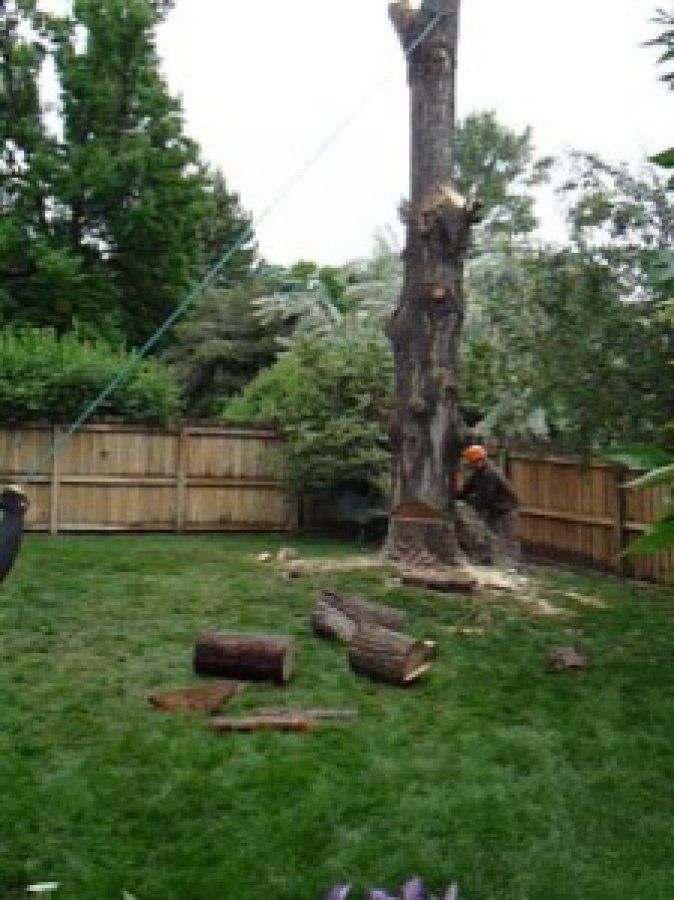
Although tree removal is a last resort, there are circumstances when it is necessary. An arborist can help decide whether a tree should be removed. Arborists have the skills and equipment to safely and efficiently remove trees.
Removal is recommended when the tree:
- is dead or dying
- is considered irreparably hazardous
- is causing an obstruction that is impossible to correct through pruning
- is crowding and causing harm to other trees
- is to be replaced by a more suitable specimen
Tree Cabling and Bracing Services
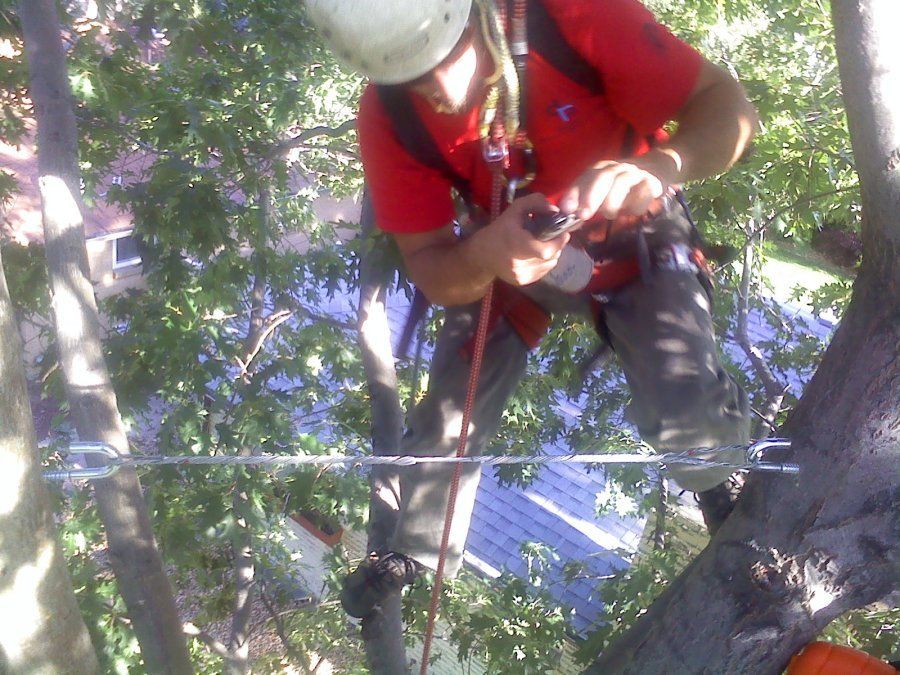
Trees can grow in such a manner that their physical structure can no longer support their own weight. This is particularly common in mature multi-trunked trees and trees with open canopies. Failure of a large branch or trunk can result in property damage, personal injury, or the decline of a tree’s health. Cables and bracing rods are tools arborists use to protect or improve the structural integrity of trees.
Tree Cabling and Bracing Overview
The installation of cables and bracing rods, along with pruning to reduce end-weight can reduce the likelihood of a structural failure. Properly installed cables help to redistribute structural stress, and bracing rods can provide support to branch attachments deemed weak. A combination of cabling and bracing can successfully address existing splitting limbs and trunks. A Certified Arborist can best determine if your trees can benefit from the installation of cables and bracing rods.
Cabling and Bracing Mature Trees
As a tree grows, the angles that exist among limbs determine structural integrity. Branches having a wide angle of attachment or a pronounced “U” shape will be stronger than that of a narrow “V” shape. When a tree is young, the stress placed on a narrow angle of attachment is usually minimal. However, as the tree matures the weight of the canopy and the additional load created by winds, snow, or wet foliage may be more than the attachment can support. In the case of Oaks an Pecans, a heavy seed crop can cause limbs to split or break. Properly placed cables can help redistribute the load allowing limbs to support each other, rather than moving independently.
Mature trees having a broad spreading canopy, such as Live Oaks, often have lower limbs that grow horizontally to the edge of the canopy. Such limbs often droop lower with the weight of and additional year’s growth. These limbs can be cabled to maintain a specific height or to provide clearance above a walk, drive, or roof. Such cabling is an alternative to the removal of large branches.
Cabling and Bracing Multi-trunked Trees
By their very nature, multi-trunked trees are subject to failure. Because each trunk competes for canopy space, the limbs and foliage grow away from the center of the collective trunks, placing the wight load on one side of each trunk. This factor, plus the competition for root space, results in the failure of multi-trunked trees at a rate greater than trees with single trunks. Failure of any singular trunk can create a wound at the collective base that heals slowly, creating a site for opportunistic insects and diseases. Cabling can substantially reduce the likelihood of structural failure. Every cable installation is tree specific. A Certified Arborist can determine the best cabling arrangement for multi-trunked trees.
Cabling and Bracing Split Trees
Trees with trunks that have narrow angles of branch attachments may develop vertical splits. Such cracks are often a result of structural stress or storm damage. When such splits are found, immediate attention is needed to prevent complete failure. Your arborist can advise you as to whether the tree should be removed or if cabling and bracing is a viable alternative. If the latter is an option, selective pruning, the installation of cables, and the proper placement of bracing rods can add years to the life of a damaged tree without affecting its aesthetic appeal.
Cabling Young Trees
Occasionally, there is a need to cable young trees. Your arborist can determine the specific installation techniques and materials appropriate for your tree’s health.
Hardware Maintenance
Tree cable and bracing hardware is subject to the elements, and thus should be inspected annually. The normal movement of branches can cause cables and hardware to wear, reducing the load carrying abilities. Annual inspections are particularly important when a cable failure might result in property damage or personal injury. A visual inspection by a Certified Arborist is usually all that is necessary. A closer inspection can be made with subsequent prunings. The need for additional cables can be determined as the tree’s canopy continues to grow.
Species Specific
Large open-canopy trees that can benefit from properly placed cabling include Live Oak, Shumard Red Oak, Texas Red Oak, Pecan, and Cedar Elm.
Multi-trunked trees that can benefit from properly placed cabling include Texas Red Oak, Shumard Red Oak, Live Oak, Cedar Elm, Arizona Ash, River Birch, and Hackberry.
Trees that are prone to vertical splitting include Live Oak, Red Oak, and American Elm.
Stump Grinding Services
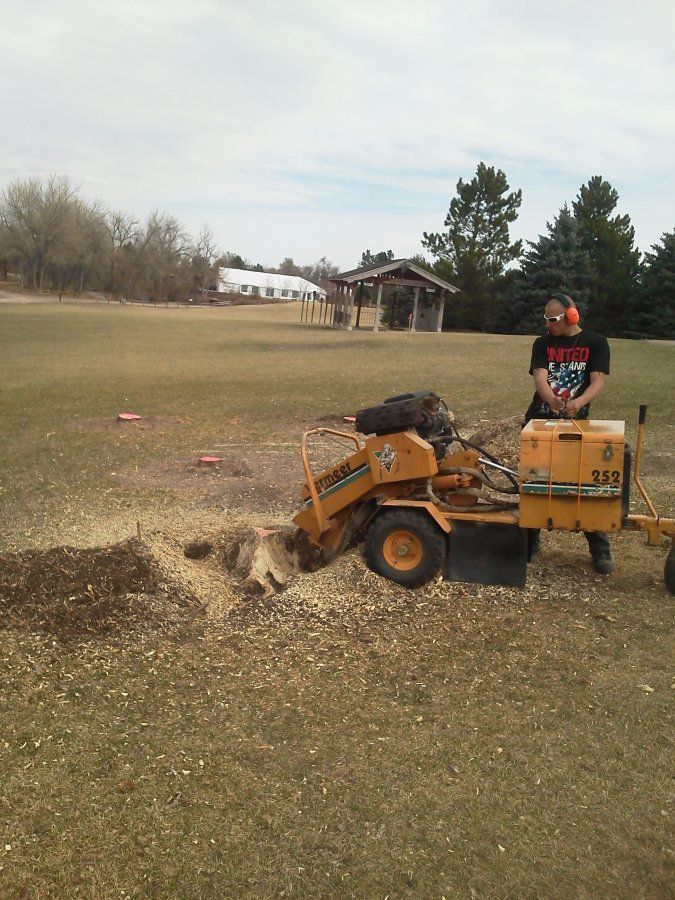
Homeowners have used many methods over the years to remove tree stumps after a tree removal. Stumps have been pulled out, dug out, burned out, or have poured various chemicals on stumps to accelerate the decay of the stump. Although there are a number of ways to remove stumps, using a stump grinder is the fastest way to remove a tree stump. A stump grinder is a specialized piece of tree care equipment that is designed specifically to grind tree stumps and grind tree roots. The stump grinder has a metal wheel with cutting teeth bolted to the wheel. The arborist grinds the tree stump by using the cutting teeth to chip away the tree stump. The wheel is passed back and forth, lowering it with each successive pass, to gradually grind tree stumps into chips.
For many years it was thought that stump grinding was an optional tree care service that wasn’t necessary if the stump was in a remote location in the landscape. However, current research indicates that grinding out tree stumps can reduce the chance of other trees in your landscape from becoming infected with tree decay fungi. Stumps that remain after a tree removal can become infected with wood decay fungi. Over time these fungi will develop spores and fungal hyphae that will grow out into the soil. If a healthy tree is wounded in the future the decay fungi will have the opportunity to infect the wound.
The depth to which a stump grinder machine can grind a stump varies from manufacturer to manufacturer. The depth to which stump grinding is done depends on what is going to happen after the tree stump is removed. If the tree stump area is going to be replanted with grass then grinding a tree stump to a depth of 4 – 6” is probably sufficient. This will allow enough soil depth for grass roots to grow. If another tree is going to be planted then the arborist can grind a deeper and wider hole to allow for space for the root ball of the new tree. If there are numerous surface roots, the stump grinder can grind out the tree roots, too. Woodchips and soil that remain after the stump grinding is completed should be removed and replaced with topsoil before replanting.
The size of the tree stump usually determines what size stump grinder an arborist will use to grind a tree stump. Stump grinder machines are available in a variety of sizes. Most stump grinders are brought to a job site on a trailer, but there are also stump grinders that are towed behind trucks.
You should advise the arborist, or tree service, that’s doing the stump grinding of any underground obstructions that may be present in your landscape, such as, electric wires for accent lighting, sprinkler lines, underground dog fences, septic fields, etc. The arborist, or yourself, should contact phone and utility companies in advance of stump grinding so the location of underground wires or pipes can be identified.
Here are a few questions to ask when you need to find a local tree service, or arborist, to grind a tree stump:
- How Deep will the stump grinder grind the tree stump?
- Will the arborist, or tree service, haul the wood chips or do they leave the wood chips?
- Is the arborist going to contact phone and utility companies to locate underground wires or pipes?
- Does the arborist, or tree service, carry proper insurance coverage for stump grinding?
Also:
- Let the arborsit, or tree service know if you want to replant a tree in the same spot or if you are just planning to reseed the stump area with grass.
- Advise the arborist, or tree service, of any known underground obstructions such as gas lines for outdoor grills, septic fields, underground dog fences, irrigation lines, etc.
Firewood Sales
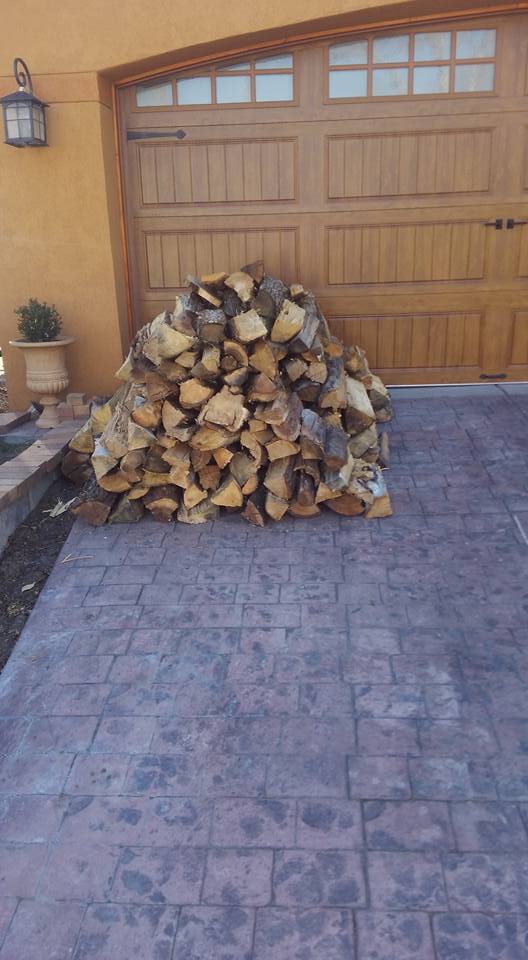
Due to the large number of Removals that we had this year. Reliable Tree Care has a large stock pile of Firewood available for purchase. We offer multiple types of Firewood, for use in heating units or in meat smokers.
Contact us today at 303-908-8122.
Heating with Firewood
Heating with wood offers both Heat and comfort. Whether you use wood as a primary source of heat or as a secondary comfort, such as sitting by a warm fireplace with a good book.
Choosing the right type of wood is important.Be sure that you do your research, and choose the right type of firewood for you and your situation. To assist with making the best decision for your situation, below you will find some information on the different types of wood that we offer.
What is a Cord?
A Cord is the common measurement used for the sell or purchase of Firewood. It is 4'x4'x8' of stacked wood totalling 128 Cubic Feet.
What are BTU's?
Before we can tell you about the types of Firewood we offer, we must first provide you with information on a key term that we will be discussing about the firewood we offer.
BTU's or British Thermal unit is the amount of energy required to heat one pound of liquid water by one degree fahrenheit. We now use BTU's to describe common things such as the amount of heat/energy generated by a furnace or by such things as wood or coal.
Types of Firewood
We offer Hard woods such as Ash, Locus, Walnut and Maple. At a rate of $300/cord.
Ash - 19.1 Million BTU's per cord.
Locus - 27.9 Million BTU's per cord.
Maple - 19.6 Million BTU's per cord.
Walnut - 22.5 Million BTU's per cord.
We offer Soft woods such as Aspen, Cedar and Pine. At a rate of $200/cord.
Aspen - 18.2 Million BTU's per cord.
Cedar - 16.0 Million BTU's per cord.
Pine - 18.3 Million BTU's per cord.
We offer Fruit woods, ideal for smoking meats, such as Apple, Apricot, Pear and Plum. At a rate of $300/cord.
Apple - 27.5 Million BTU's per cord.
Apricot - 28.3 Million BTU's per cord.
Pear - 32.0 Million BTU's per cord.
Plum - 25.6 Million BTU's per cord.
The above BTU amounts are industry standard amounts, that can vary depending on a number of conditions. As long as it is a good quality piece of wood, a few BTU's variance really will not make a huge difference.
